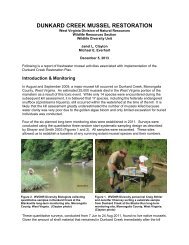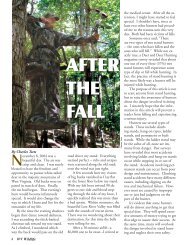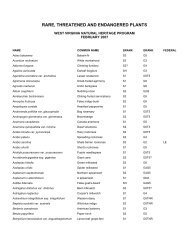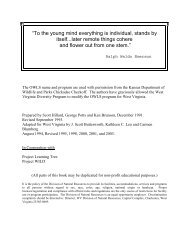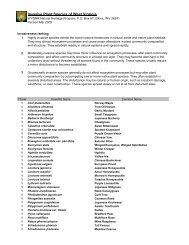Snakes - West Virginia Division of Natural Resources
Snakes - West Virginia Division of Natural Resources
Snakes - West Virginia Division of Natural Resources
You also want an ePaper? Increase the reach of your titles
YUMPU automatically turns print PDFs into web optimized ePapers that Google loves.
Mark Watson<br />
EASTERN WORMSNAKE (Carphophis a. amoenus)<br />
Smooth scales, a small pointed head and a tail ending in a spinelike<br />
tip identify the Eastern Wormsnake. Seldom exceeding one foot in<br />
length, Wormsnakes have been collected throughout the state from bur-<br />
rows in the soil, organic debris and rotting logs. Prey consists <strong>of</strong> insects<br />
and earthworms. Two to six small, white, elliptical eggs are laid under<br />
rocks, in loose soil or rotting wood.<br />
NORTHERN BLACK RACER (Coluber c. constrictor)<br />
This snake is slender, glossy black in color and may attain a length<br />
<strong>of</strong> six feet The dorsal scales are smooth and the chin and throat are<br />
white. Black Racers<br />
occur throughout the<br />
state in moist woodlands<br />
and fields, where<br />
they feed on birds and<br />
mammals, as well as<br />
amphibians and reptiles.<br />
Approximately 25<br />
<strong>of</strong>f-white, elliptical eggs<br />
are deposited in loose<br />
soil or sawdust piles. Hatchlings have 30 or more reddish brown blotches<br />
on a gray background. The banded juvenile pattern slowly disappears<br />
as the snake grows larger, and the snake is completely black by the time<br />
it reaches 30 inches in length.<br />
11<br />
Mark Watson



